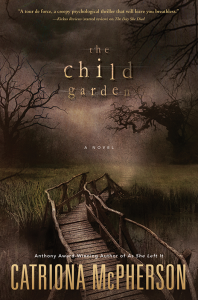Three Questions with…Catriona McPherson
 True story. When I first met Catriona McPherson, I hadn’t read her work. But I liked her so much as a person that I decided, of course, that I would pick up the first in her Dandy Gilver mystery series. Until I did, I hoped hoped hoped that I would like her writing—it’s so much easier to be friends that way. And then the skies parted and the angels sang. Because I adored Catriona’s writing. By the time I saw her again a year later, I’d read every mystery she’d ever published (eight books, I think) and was clamoring for more.
True story. When I first met Catriona McPherson, I hadn’t read her work. But I liked her so much as a person that I decided, of course, that I would pick up the first in her Dandy Gilver mystery series. Until I did, I hoped hoped hoped that I would like her writing—it’s so much easier to be friends that way. And then the skies parted and the angels sang. Because I adored Catriona’s writing. By the time I saw her again a year later, I’d read every mystery she’d ever published (eight books, I think) and was clamoring for more.
And then she started publishing these dark contemporary suspense novels and my head promptly exploded.
Well, you’re in for a treat—and a trip to the bookstore—because today Catriona joins me to answer three nosy-cow questions from someone who really wants to know how she does it.
Three Questions with Catriona McPherson
The main character of The Child Garden, Gloria Harkness, is unglamorous and unapologetic—and I love her. Can you talk a little bit about where she came from and how she became the lens for readers for this story?
Actually, for once, I can. I’m towards the organic end of the spectrum and I do very little plotting and planning before I wade in. In the case of The Child Garden, though, I had to go looking for Gloria. When I started the first draft she was hiding behind some chick called Tash—short for Natasha—who was about thirty and rather dashing. Tash’s story, unfortunately, felt and smelled like dead meat. Then one night, I was driving home from a library-do in Scotland, back to my mum’s house, and suddenly the name “Gloria” popped into my head.
I knew immediately that “Gloria” was closer to forty and not at all dashing: she wore her hair in two plaits (US braids?) pinned to her head and made her own shirt-waister dresses. The funny thing was that Gloria, from the off, was a lot more confident than Tash—unapologetic is exactly right.
 There was a bit of magic in this book—the eerie kind. What role did you want the rocking stone Gloria guards to play in the story?
There was a bit of magic in this book—the eerie kind. What role did you want the rocking stone Gloria guards to play in the story?
Ah, back to normal. I have no memory whatsoever of when or why the rocking stone came to be part of The Child Garden. I’m kind of fascinated by the ancient standing stones that are so common all over Scotland. (Funnily, enough, I’ve never been to Stonehenge, though.) They freak me out a bit but I’m drawn to them. And rocking stones—where a stone moves when you nudge it—are very rare. Oh wait, I remember! At first, the stone in the garden of Rough House only existed as a reason for Gloria to live there—as its custodian, like you say.
Then it turned out that the story of what went down in the woods around Rough House twenty years before the book opens included the Beltane rituals (May Day), a devil’s bridge, a consecrated chapel type thing and—as so often happens when I’m writing—it all got a bit Gothic. The rocking stone was right there and was swept up into the general tone.
You balance a delightfully charming historical mystery series and then a new line of stand-alones, all creepy as hell. How is that schizophrenia coming along and how do you make it all work, besides just being incredibly talented?
Oh now stop it, Lori. Truth is I’ve always done both. The first version of Come to Harm (May 2015) [editor’s note: Lori also loved this book] was the first novel I ever wrote, in 2001. Also, I think they’re more similar on the inside than the jackets would have you believe. The Dandy Gilver stories are not as light, bright and sparkling (if I can steal from the blessed Jane) as they could be given the butlers, Dalmatians, and fabulous clothes, and the standalones, while they’ve got dark elements, always have some laughs too.
As far as writing challenge goes, 1930s style is harder than contemporary—all those lurking anachronisms!—and writing from scratch is harder than settling back in for another adventure with my old pals. So the two strands come out even. The easy one is always “whatever I’m not writing” and the impossible one is always “this one right here today.” I do love it though. Even on the worst writing day, writing is still the best job in the world.
__
Catriona McPherson writes the Agatha and Macavity award-winning Dandy Gilver detective series, set in her native Scotland in the 1920s. The latest, A DEADLY MEASURE OF BRIMSTONE, won a third consecutive Left Coast Crime award this year. In 2013 she started a strand of darker (that’s not difficult) standalones. The first, AS SHE LEFT IT, won an Anthony award and THE DAY SHE DIED was shortlisted for an Edgar award. THE CHILD GARDEN is just out from Mystery Ink.
Catriona immigrated to America in 2010, and lives in northern California with a black cat and a scientist. She is proud to be the 2015 president of Sisters in Crime. www.catrionamcpherson.com